

|
Back to |
| The Front Page |
| News & Features |

|
The 'AZ Closed' moves east to Jacksonville |
||||||||||
|
by Bob Alman Photos by Mike Orgill and Fred Hunt; all black-and-white photos by Mike Orgill Stroll through our Digital Gallery for more photos and better views. Posted May 17, 2016
|
||||||||||
|
||||||||||
In the beginning, before there was a USCA, there was Arizona. A gaggle of sporty guys had somehow found out about Association Croquet and learned to play it well in virtual isolation from the great world beyond Arizona, but with occasional contacts with visitors from foreign lands. And they made their own visits to such American iconoclasts as "Captain Tucker" of Santa Barbara, who in the Eighties became famous for condemning absolutely the dreaded, loathed and thoroughly reprehensible "Osborn Dead Game." The Arizona Croquet Club was formally organized in 1975, a couple of years before the beginning of the USCA, and 1983 saw the introduction of the Arizona Open.
These sporty guys in Arizona were so serious they built their own courts--among the first "regulation" courts in America. Stan Patmor had a 3/4 size court in his back yard. But Ren Kraft, a pilot who lived in Paradise Valley, built a full-size court in his backyard which became the heart and soul of the much beloved Arizona Open--a USCA-sanctioned American Rules event!
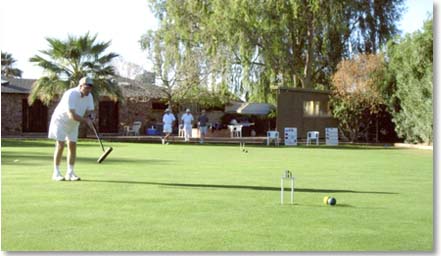
|
| The Arizona Croquet Club's recent loss of the Kraft court and patio in Paradise Valley--long the heart and soul of the Arizona Open--dealt a serious blow to a venerable tradition. Mike Orgill photo. |
Yes, you read that right: These guys had learned to play the dreaded "dead game" so well that they started winning major USCA championships in the mid-Eighties, knocking off the Easterners in their own game, starting with Jim Bast, USCA singles and double champion in 1984, then Ray Bell in 1985. Beginning around that time, the Arizona Open itself was usually dominated by strong Western players, as the "Western killers" (so-called by Jack Osborn, USCA president) began to win everything they competed in.
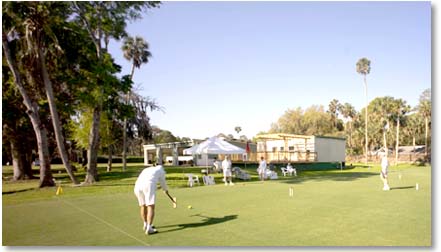
|
| Playing space for the AZ Closed was more than adequate on the three fully matured and excellent courts on the north side of Ponte Vedra. The Players Pavilion and the four south courts are seen in the distance. Mike Orgill photo. |
Players--including San Franciscans like me--loved to go the Arizona Open, because that was where everyone from everywhere went to play--even the Easterners--and it was a great croquet adventure, limited to one- and two-lawn venues scattered all over the great Phoenix area.
| ARIZONA'S COURTS WERE EVERYWHERE |
|
Part of the experience of the Arizona Open was traveling from court to court across the valley to mostly one-court venues. They included the bowling lawns in Sun City, the Venture Out Retirement Community in Mesa, the Barber home in Scottsdale, the Fournier's court in Phoenix as well as the Chatham lawn (perhaps the best-playing court in the country at the time), the Gainey Ranch in Scottsdale, Paradise Valley Country Club in Paradise Valley, Stan Patmore's 3/4 court in Phoenix, and the Kraft Court where the famous and much imitated "Toast and Talley" tradition was created. - Rory Kelley
|
But much later--after I learned to play breaks--I figured out that the weird success of my ignorant novice play probably unnerved the poor man. I did know enough to get off the court to avoid easy attack--so I had gotten a lot of practice doing cut rushes to position from the sideline, clearing a hoop, getting off the court, then repeating for the next hoop--especially easy to do on a 3/4 size court.
When Pearman, playing correctly, repeatedly went partner dead to attack me on a boundary and went out of bounds on the ice, instead of using his ball for a break, I ignored it, cut-rushed my own ball to the next wicket, and left him there, partner dead and--understandably in retrospect--flummoxed.
The Youngs of Bermuda went to the AZ Open every year. When I beat Nelga on the Fournier court, future American wunderkind Jacques Fournier was not yet competing, just hitting croquet balls around on the putting green in back. Nelga commented, "You wouldn't have beaten me on a flat lawn," and she was probably right. The first version of the Fournier court had been sodded in their front yard, and though it was a "regulation" court, it wasn't completely flat. I had learned to play swales and read lawns on San Francisco's public courts, but Nelga was not accustomed to such conditions.
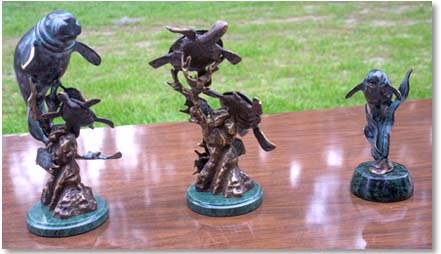
|
| Trophies of the Arizona classic were always very special. The big one, in this case, is the image of a manatee, while lessor but still valued sea creatures adorn the second and third place trophies, above a table bearing a banner of seahorse logo of the Ponte Vedra Croquet Club. Mike Orgill photo. |
The famous playboy Archie Peck from Palm Beach, however, beat me soundly on a bumpy makeshift court set on what seemed to me must have been a corn field.
On a super-fast bowling lawn in Sun City, I had the signal honor of being the victim of the first-ever sextuple in American Rules, done to me by world champion Robert Fulford.
I remember watching San Francisco-trained Wayne Rodoni defeat Teddy Prentis at the Phoenician Hotel and Resort later in the Eighties.
Another year, later still, I watched my croquet pal and frequent partner Mike Orgill win the Arizona Open doubles with partner Phil Arnold on the Gainey Ranch court in Scottsdale.
But the main action was usually at the Ren Kraft court, where on his courtside patio much of the social activity also happened after play ended at a daily "Toast and Tally" when all the scores were collected and tabulated, while much beer and munchies were consumed around a huge fire pit between the court and the main house. After the initial block play, near the tiny clubhouse, players would examine a giant display charting Arizona's unique triple-elimination finals ladder.
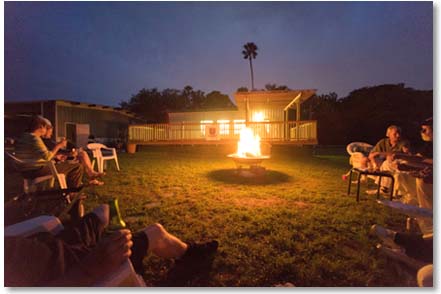
|
| After-play camaraderie around the traditional fire pit at the now-lost Kraft Court in Arizona is recreated in this toast-and-tally circle between the PVCC's north courts and clubhouse. Mike Orgill photo. |
The Arizona Open was eventually eclipsed in the West by the San Francisco Open--stronger than the USCA nationals for half a dozen years in the mid-90's, bolstered by the international players who came down to play in the annual Sonoma-Cutrer event and the strong players at the Sonoma-Cutrer Croquet Club. But somewhere around the year 2000, the center of "player power" moved to North Carolina, where it remains.
All this time, croquet continued in Arizona, though the Arizona Open died a slow and natural death. So seven years ago Rory Kelly, Ren Kraft, and the late Steve Johnston decided to host for a close circle of favorite croquet friends an "AZ Closed." It worked fine until last year, when suddenly the Kraft Court was lost as Ren down-sized his now-empty nest. And in the meantime, most of the once-available croquet courts in the area had either been recycled for other purposes or had degraded in quality.

|
| Pam Johnston stands beside a dedication to her late husband on the deck overlooking the north lawns and leading into the clubhouse. Fred Hunt photo. |
So what could be more natural, when the widow of Steve Johnston, one of those favorites, suggested that they play the Arizona Closed in North Florida? Pam Johnston would do a lot of the social hosting of the event at Sawgrass, the Johnstons' winter home. And she could also play in the tournament as the only female competitor, one of the original 12 in the AZ Closed. It had been Steve's dream to play at least one AZ Closed at Ponte Vedra, so Pam was acting on Steve's wishes. (Next year's AZ Closed will continue at the home of Stephanie and Doug Grimsley in Vienna, Virginia.)
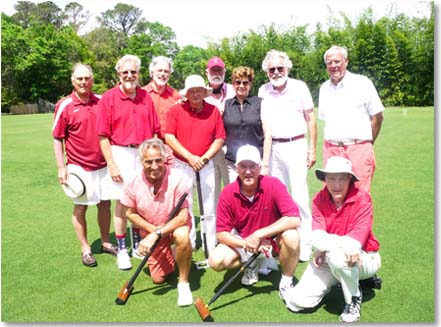
|
| The players and the host on finals day are (standing, left to right) Jim Irwin, Erv Peterson, Rich Curtis, Ren Kraft, Charlie Smith, Pam Johnston, Rory Kelley, John Curington; and (kneeling) Mike Zuro, Britt Ruby, and Mike Orgill. |
What better place to play than Ponte Vedra! Its three fully matured north lawns would be more than sufficient, and after Steve died, the event would be a kind of memorial to him, co-hosted by Pam and John Curington around his clubhouse and deck commemorating the Johnston's considerable contribution to the establishment of the nation's third-largest croquet facility (after the National Croquet Center in Florida and Mission Hills in California) as Ponte Vedra's first Lifetime Members.
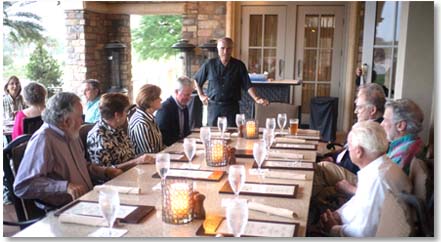
|
| Sawgrass--the Johnstons' winter home in Jacksonville--was the site of the "official" dinners and socials not held on the grounds of the Ponte Vedra Croquet Club. The April weather was ideal for patio dining. Mike Orgill photo. |
So the guys--and one girl--came to play their beloved event in Ponte Vedra in early April, with the full encouragement and support of John Curington, the owner and developer of the PVCC. It was a great and fun event, presaging a future of many brilliant events in one of the biggest and soon to be one of the most beautiful all-for-croquet venues in the United States.
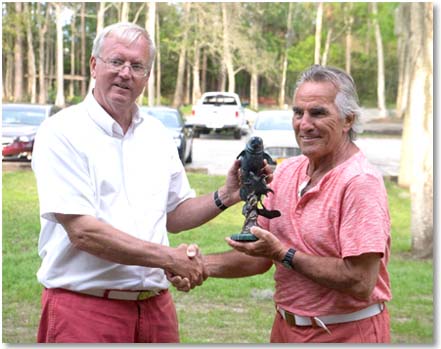
|
| Host John Curington congratulates winner Mike Zuro, wearing pink. The tradition of the AZ Closed allows this year's winner to pick the colors of next year's final day, when the whites rule is retired. Does anybody know which color Zuro will choose? Would polka dots or stripes be allowed? Mike Orgill photo. |
The pictures in this article--and in the walk-through digital gallery--show you something of the spirit of the old Arizona Open as well as the promise of the brand new and still-being-developed Ponte Vedra Croquet Club.